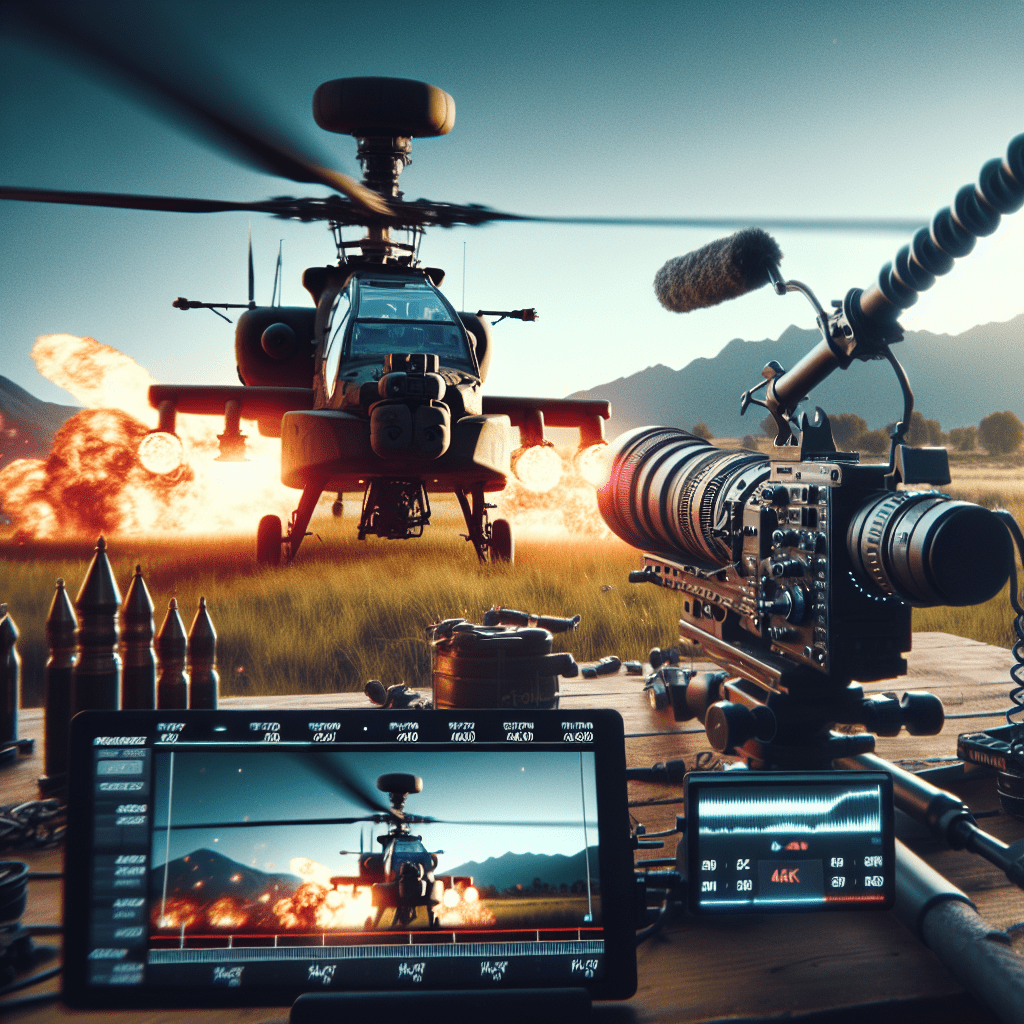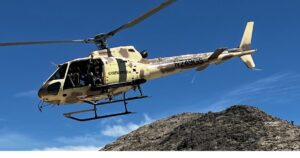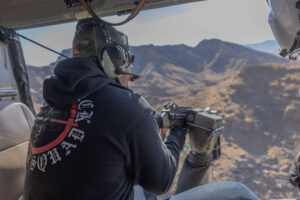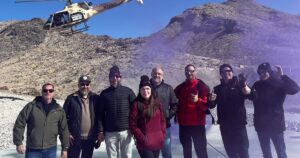“Behind the Scenes: The Making of a Helicopter Gun Range” provides an in-depth look into the complex process of creating a training facility for helicopter-mounted weaponry. This comprehensive guide explores the intricate planning, design, and construction stages involved in creating a realistic and safe environment for training military personnel. It also delves into the technological advancements and safety measures incorporated in these ranges, ensuring optimal performance of both the helicopters and their onboard weapons systems. The introduction offers a glimpse into the rigorous standards and meticulous attention to detail required in the creation of such a specialized military training facility.
Unveiling the Process: Helicopter Gun Range Creation
Behind the Scenes: The Making of a Helicopter Gun Range
The creation of a helicopter gun range is a complex process that involves meticulous planning, engineering prowess, and a deep understanding of both aviation and ballistics. This intricate process is a testament to the ingenuity and dedication of the professionals involved, who work tirelessly to ensure that the range is not only functional but also safe and efficient.
The first step in creating a helicopter gun range is the selection of an appropriate location. This involves a careful analysis of the terrain, weather patterns, and local regulations. The location must be remote enough to minimize the risk of accidents, yet accessible enough for the helicopters and personnel. It also needs to be large enough to accommodate the flight paths of the helicopters and the trajectories of the projectiles.
Once the location has been selected, the next step is the design of the range itself. This involves a detailed understanding of the capabilities of the helicopters and the weapons they will be using. The range must be designed to allow for a wide variety of maneuvers and firing angles, while also providing adequate safety measures. This includes the installation of bullet traps and barriers to prevent stray projectiles from causing harm.
The design process also involves the creation of targets for the helicopters to engage. These targets can range from simple static structures to complex moving targets that simulate enemy vehicles or personnel. The design of these targets is a critical aspect of the range, as they need to provide a realistic and challenging environment for the pilots and gunners.
Once the design is complete, the construction phase begins. This involves the physical creation of the range, including the installation of the targets and safety measures. The construction process is a labor-intensive task that requires a high level of precision and attention to detail. Every aspect of the range, from the placement of the targets to the layout of the flight paths, must be executed with exacting precision.
After the construction is complete, the range must be thoroughly tested before it can be used. This involves a series of test flights and firing exercises to ensure that everything is functioning as intended. Any issues or problems that are identified during this testing phase must be addressed and corrected before the range can be officially opened.
The creation of a helicopter gun range is a complex and demanding process, but it is also a fascinating testament to the capabilities of modern engineering and design. It requires a unique blend of skills and knowledge, from aviation and ballistics to construction and safety. The end result is a facility that provides a vital training environment for helicopter crews, helping them to hone their skills and prepare for the challenges they will face in the field.
In conclusion, the making of a helicopter gun range is a meticulous process that involves careful planning, detailed design, precise construction, and thorough testing. It is a testament to the dedication and expertise of the professionals involved, who work tirelessly to create a facility that is not only functional but also safe, efficient, and challenging. It is a behind-the-scenes process that is often overlooked, but it is a critical component of modern military training.
Aerial Range Insights: Understanding the Complexities of Helicopter Shooting Range Setup

Behind the scenes of the creation of a helicopter gun range, a complex and intricate process unfolds. This process involves a blend of advanced technology, rigorous safety measures, and precise engineering. The making of a helicopter shooting range is not a simple task; it requires a deep understanding of the complexities involved, from the initial design phase to the final implementation.
The first step in setting up a helicopter gun range is the design phase. This involves a team of experts who meticulously plan the layout of the range, taking into consideration various factors such as the size of the range, the types of helicopters that will be using it, and the specific training requirements. The design must also account for safety measures, ensuring that the range is not only functional but also safe for use.
Once the design is finalized, the next step is the construction phase. This involves the physical building of the range, which can be a complex process due to the unique requirements of a helicopter gun range. For instance, the range must be built in a way that allows for the safe takeoff and landing of helicopters, while also providing a suitable environment for shooting practice. This often involves the use of advanced construction techniques and materials, to ensure that the range is both durable and effective.
The construction of the range is followed by the installation of the necessary equipment. This includes the targets, which are typically computer-controlled to simulate various scenarios and provide a realistic training environment. The range also requires specialized equipment for tracking the accuracy of shots, which is crucial for evaluating performance and identifying areas for improvement.
Once the range is built and the equipment is installed, the final step is the testing phase. This involves a series of rigorous tests to ensure that the range is functioning as intended. These tests include checking the accuracy of the targets, testing the safety measures, and conducting trial runs with helicopters. Any issues identified during the testing phase are addressed and corrected before the range is officially opened for use.
Throughout the entire process, safety is a paramount concern. Every aspect of the range, from the design to the construction to the equipment, is carefully evaluated to ensure that it meets the highest safety standards. This includes not only the safety of the pilots and crew using the range, but also the safety of the surrounding environment.
In addition, the making of a helicopter gun range also involves a significant amount of training. This includes training for the pilots and crew who will be using the range, as well as training for the personnel who will be operating and maintaining the range. This training is crucial for ensuring that the range is used effectively and safely.
In conclusion, the making of a helicopter gun range is a complex process that involves a blend of advanced technology, rigorous safety measures, and precise engineering. It requires a deep understanding of the complexities involved, from the initial design phase to the final implementation. However, the result is a state-of-the-art facility that provides a realistic and effective training environment for helicopter crews, contributing to their readiness and effectiveness in real-world scenarios.
Behind the Scenes: The Intricate Steps in Building a Helicopter Gun Range
Behind the Scenes: The Making of a Helicopter Gun Range
The creation of a helicopter gun range is a complex process that requires meticulous planning, engineering prowess, and a deep understanding of both aviation and ballistics. This intricate task involves several stages, each of which is crucial to the successful operation of the range.
The first step in the process is the selection of an appropriate location. This involves a careful assessment of the terrain, the surrounding environment, and the potential impact on local communities. The site must be large enough to accommodate the range, with sufficient buffer zones to ensure safety. It must also be relatively isolated to minimize noise and other disturbances.
Once a suitable location has been identified, the next step is the design phase. This involves creating a detailed blueprint of the range, taking into account factors such as the flight paths of the helicopters, the placement of targets, and the safety measures that need to be in place. The design must also consider the specific requirements of the helicopters that will be using the range, including their size, speed, and weaponry.
The design phase is followed by the construction phase, which involves the physical creation of the range. This includes the building of the launch and landing pads, the installation of the targets, and the creation of the safety zones. The construction process must adhere to strict standards to ensure the durability and reliability of the range.
The construction of the range is only part of the story, however. Equally important is the installation of the necessary equipment and technology. This includes radar systems to track the helicopters and their projectiles, communication systems to coordinate the activities on the range, and scoring systems to evaluate performance.
Once the range is built and equipped, it must be thoroughly tested before it can be put into operation. This involves a series of trial runs, with helicopters firing at the targets and the systems monitoring their performance. Any issues that arise during these tests must be addressed and resolved before the range can be officially opened.
The final step in the process is the training of the personnel who will operate the range. This includes not only the pilots who will be flying the helicopters, but also the ground crew who will maintain the range and the technicians who will operate the equipment. This training is critical to the safe and effective operation of the range.
The creation of a helicopter gun range is a complex and demanding process, requiring a high level of expertise and a commitment to safety and precision. It is a testament to the skill and dedication of those involved that these ranges can provide a valuable training resource for military and law enforcement agencies, helping to ensure that their helicopter crews are prepared for the challenges they will face in the field.
In conclusion, the making of a helicopter gun range is a fascinating blend of science, engineering, and logistics. It is a process that requires careful planning, meticulous execution, and constant monitoring to ensure that it meets the highest standards of safety and performance. It is a behind-the-scenes endeavor that is often overlooked, but without which our helicopter forces would be significantly less prepared for their vital roles in defense and law enforcement.
Q&A
1. Question: What is involved in the making of a helicopter gun range?
Answer: The making of a helicopter gun range involves designing the range layout, installing targets, and setting up safety measures. It also includes the integration of tracking systems for the helicopters and the bullets they fire.
2. Question: What safety measures are taken during the making of a helicopter gun range?
Answer: Safety measures during the making of a helicopter gun range include setting up a secure perimeter to prevent unauthorized access, installing bullet traps and backstops to contain stray bullets, and ensuring a safe distance between the firing range and any populated areas.
3. Question: What kind of tracking systems are used in a helicopter gun range?
Answer: In a helicopter gun range, radar tracking systems are often used to track the helicopters’ movements, while acoustic sensors or high-speed cameras may be used to track the trajectory of the bullets.The making of a helicopter gun range involves a complex and meticulous process that requires expertise in various fields such as engineering, aviation, and weaponry. It showcases the integration of advanced technology and strategic design to create a training environment for helicopter gunship crews. The process underscores the importance of precision, safety, and realism to effectively prepare the crews for real-life combat situations.






